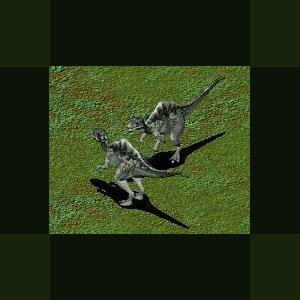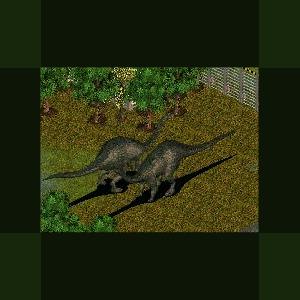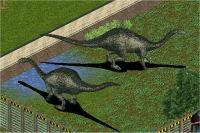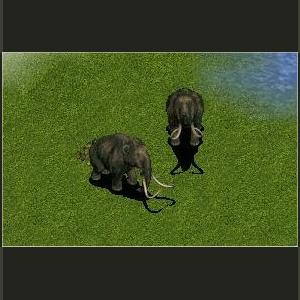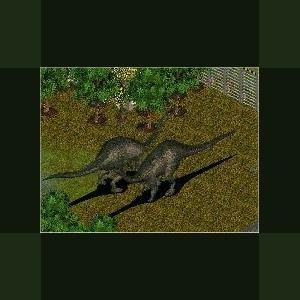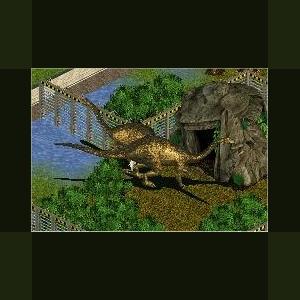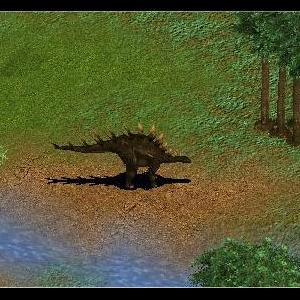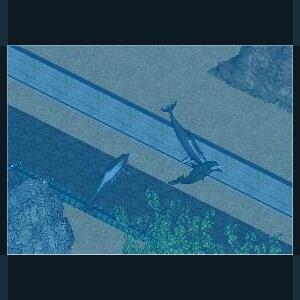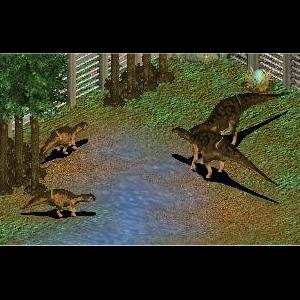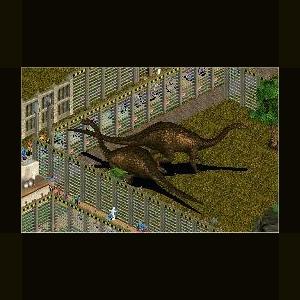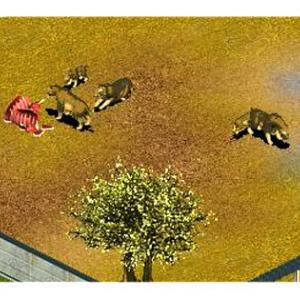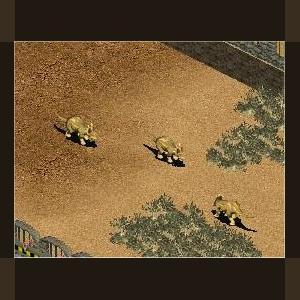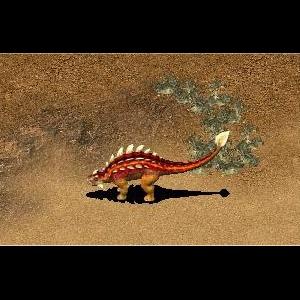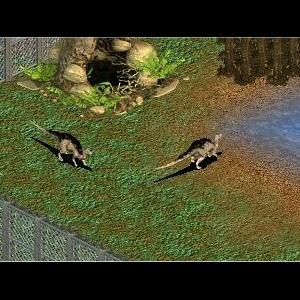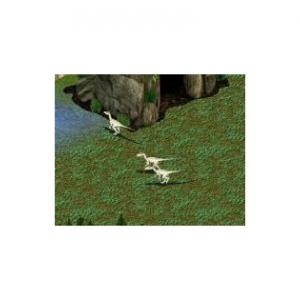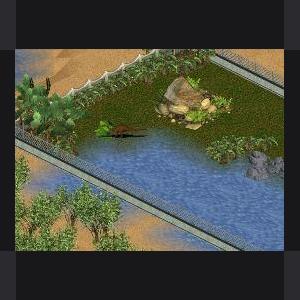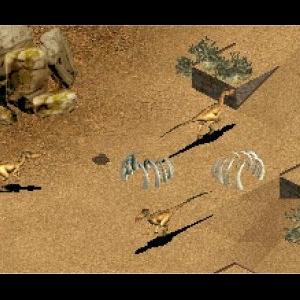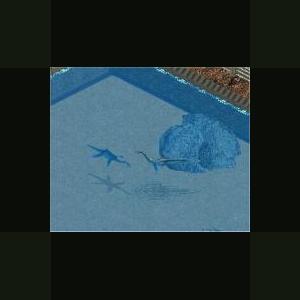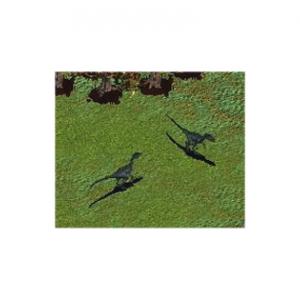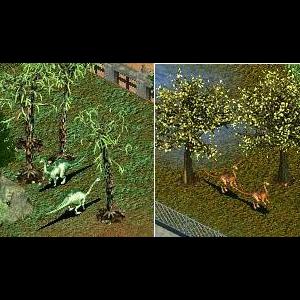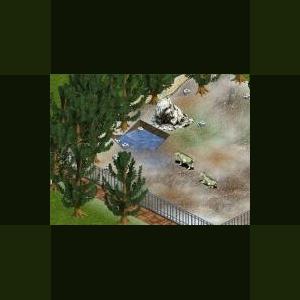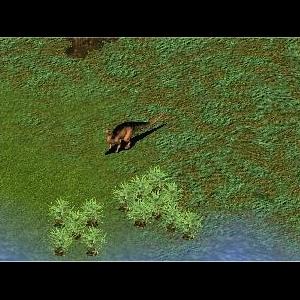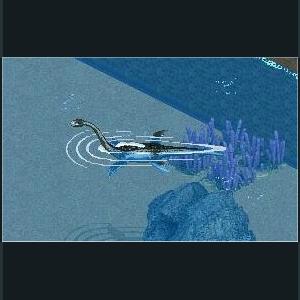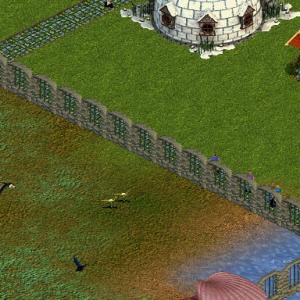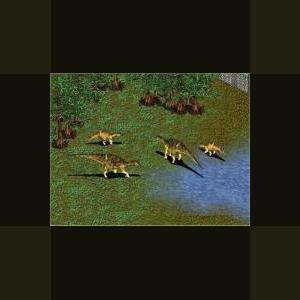Dinosaurs
Creatures from another age
241 files
-
Irritator by Moondawg
By Guest
Irritator is a genus of spinosaurid dinosaur that lived in the early Cretaceous Period (Albian stage), around 110 million years ago.
Current estimations indicate a length of 8 meters (26 feet) and a height of 3 meters (9 feet). It was found in Brazil. Irritator was a theropod with an unusually shaped crest at the rear of its head, and probably ate fish.
So far the only fossil that has been found was an 80 centimeter long fossil skull in the Romualdo Member, a layer member of the Brazilian Santana formation. This skull strongly resembles the skulls of Suchomimus and Spinosaurus. The genus is often regarded today as identical (synonymous) with Angaturama, which lived in the same time and the same place as Irritator.
Irritator was first scientifically described in 1996 by paleontologists Martill, Cruikshank, Frey, Small and Clarke. Its only known fossil, an 80cm skull discovered in eastern Brazil, was badly obscured by plaster which was added by the commercial fossil-collecting amateurs who discovered it, and illegally sold it, since the trade of fossils is prohibited by law in Brazil, in hopes of making the fossil look more complete and valuable. It required a great deal of work to reconstruct the original features — hence the name.
It is probably synonymous with Angaturama limai, another spinosaurid from the same time and place, whose remains curiously seem to complete Irritator's skull, meaning that they could belong to the same specimen.
Material of I. challengeri, not counting that of A. limai, hails from the Romualdo Member of the Santana Formation in Brazil. The holotype is SMNS 58022, from the Stuttgart State Museum of the Natural Sciences, and it consists of an incomplete skull, lacking the anterior (front) portion.
The skull was recovered nearly complete and is considered the most complete head find of a Spinosaurid. It is characterized particularly by its unusual length and curved lip region, which is strongly compressed laterally. The overall length of the complete head is estimated at approximately 84 centimeters. It possesses a clear Sagittal crest; such a comb is found also with some other dinosaurs. The teeth exhibit a single embedding of the strongly extended and straight teeth with conical tooth crowns, which indicates a continual tooth change, as new teeth were pushed up between the old ones. The teeth exhibit lengths from 6 to approximately 40 millimeters.
In the year 2004 parts of a spinal column were discovered in the Santana Formation. These have been assigned, due to their structure, to the Spinosauridae. With very high probability these fossils belong to Irritator, since this is the so far the only so far well-known Spinosaurid of the formation.
Sorry I couldn't make the sail smaller so i left it as is :D
303 downloads
0 comments
Updated
-
Titanosaurus by Ghirin
By Guest
Titanosaurus (“Titanic Lizard”) was the first found of a distinct group of sauropods, the Titanosauria. This group of sauropods lasted from the late Jurassic to the late Cretaceous periods and seems to be indigenous to the southern hemisphere.
Titanosaurus looked similar to the Diplodocidae, having both a long neck and a whip-like tail. However, the skin on its back was studded with small bony plates called osteoderms.
References:
http://dinosauricon.com/genera/titanosaurus.html
Encyclopedia of Dinosaurs and Other Prehistoric Creatures. Malam and Parker, 2002
Dinosaurs. Parker, 2003
Created by Ghirin, 2004
297 downloads
0 comments
Updated
-
Cetiosaurus by Ghirin
By Guest
This therapod had a pair of bony ridges above its eyes and a horn on its snout. These were probably used by males when fighting for a mate.
Ceratosaurus (cera-TO-saur-US ) meaning 'horned lizard', in reference to the horn on its nose (Greek keras/keratos meaning 'horn' and sauros meaning 'lizard'), was a large predatory dinosaur from the Late Jurassic Period, found in the Morrison Formation of North America, in Tanzania and Portugal. It was characterized by large jaws with blade-like teeth, a large, blade-like horn on the snout and a pair hornlets over the eyes. The forelimbs were powerfully built but very short. The bones of the sacrum were fused (synsacrum) and the pelvic bones were fused together and to this structure (Sereno 1997) (i.e. similar to modern birds). A row of small osteoderms was present down the middle of the back.
186 downloads
0 comments
Updated
-
Steppe Mammoth by Ghirin
By Guest
Steppe Mammoth by Ghirin
The steppe mammoth (Mammuthus trogontherii) lived on the steppes that covered large portions of Eurasia.
This grassland was south of the ice sheets, but was still colder than the steppes of today.
The steppe mammoth may be descended from the ancestral mammoth, Mammathus mridionalis. It gave rise to the woolly mammoth of the late Pleistocene.
*Inspired by the Zoo tycoons brains trust at the Zoo Tek Evolved Forums.*
440 downloads
0 comments
Updated
-
Diplodocus by Ghirin
By Guest
Diplodocus ("Double Beam") was one of the sauropods found during the North American "Bone Rush" of the late 1800's. At that time, Diplodocus was the longest known dinosaur, though more recently discovered dinosaurs such as Supersaurus are longer. Even with its great length, Diplodocus was relatively light-weight (compared to Barosaurus and Apatosaurus).
Diplodocus' long, sloping skull became the type for a group of dinosaurs with similar skulls (the Diplodocidae). Other important features of Diplodocus include a long tail with a whip-like ending (possibly an anti-predator defense), a long neck, and skid-like projections on the vertebra of the middle tail region.
References:
http://dinosauricon....diplodocus.html
Encyclopedia of Dinosaurs and Other Prehistoric Creatures. Malam and Parker, 2002
Dinosaurs. Parker, 2003
Created by Ghirin 2004
367 downloads
0 comments
Updated
-
Omeisaurus by Ghirin
By Guest
Omeisaurus by Ghirin
Description : Omeisaurus ("Mount O-mei Lizard") was a large sauropod from China.
It had a very long neck and some scientists think that it might be related to Mamenchisaurus. Others think that its more closely related to Shunosaurus.
176 downloads
0 comments
Updated
-
Huayangosaurus by Ghirin
By Guest
Huayangosaurus by Ghirin
The primitive stegosaur Huayangosaurus ("Lizard from Huayang") lived in China during the middle Jurassic period.
Reference:
www.wikipedia.org
*Inspired by the Zoo Tycoon Braind Trust at the Zoo Tek Forums*
Created by Ghirin 2007
189 downloads
0 comments
Updated
-
Prosqualodon by Ghirin
By Guest
Prosqualodon by Ghirin
Prosqualodon ("Before the Shark-Tooth") was a toothed whale that resembled a modern dolphin in both size and build. It's teeth, however, were more like the ancient shark-toothed whales than the modern toothed whales. It lived during the Oligocene and the Miocene eras.
397 downloads
0 comments
Updated
-
Maiasaura by Ghirin
By Guest
Maiasaura
Author: Ghirin
http://www.zoo-tek.com/forums/index.php?download=782
Maiasaura ("Good Mother Lizard") formed large nesting colonies of up to 10,000 animals. Young Maiasaurs were cared for in the nest by adults until they were strong enough to follow the herd.
*Inspired by the Zoo Tycoon Brains Trust at the Zoo Tek Evolved Forums.*
341 downloads
0 comments
Updated
-
Barosaurus by Ghirin
By Guest
Barosaurus (“Heavy Lizard”) was a member of the Diplodocidae and a close relative of both Apatosaurus and Diplododus. This particular family of sauropods was named after the beam-shaped bones in their tails.
Barosaurus fossils have been been found in two locations. It ws first identified in western North America. Recently, Barosaurus fossils have been discovered in Tanzania.
References:
http://dinosauricon.com/genera/barosaurus.html
Encyclopedia of Dinosaurs and Other Prehistoric Creatures. Malam and Parker, 2002
Dinosaurs. Parker, 2003
Created by Ghirin 2004
253 downloads
0 comments
Updated
-
Machairodus Giganteus by Ghirin
By Guest
Machairodus was a genus of large saber-toothed cats found in Eurasia, Africa and North America. These sabertooths thrived over the period covered by the mid-Miocene to the mid-Pliocene (15 to 2 million).
Machairodus giganteus, the size of a modern lion or tiger, was the largest and most specialized member the genus in Eurasia. Its skull was longer and narrower than a modern lion and the teeth had serrations along the edges.; in addition, M. giganteus also had longer legs than some other species of Machairodus. There was a small flange on either side of the chin to provide support for the sabers when the mouth was closed.
It lived in mixed habitats of savannah and broadleaf evergreen trees and might have had a lifestyle similar to that of modern lions. M. giganteus also might have had a tawny brown coat to help it blend in with its surroundings.
Referrences:
Big Cats and Their Fossil Relatives by Anton, Clark and Turner, 2000.
Mammoths, Sabertooths and Hominids by Agusti and Anton, 2002.
http://www.bluelion.org/lowgraphmachairodus.htm
Created by Ghirin 2003
372 downloads
0 comments
Updated
-
Protoceratops by Ghirin
By Guest
Protoceratops ("Before the horned-faces") is well known from numerous skeletons, ranging from young animals to adults. It was a common dinosaur from Cretaceous Mongolia.
Reference:
The Illustrated Encyclopedia of Dinosaurs by Dougal Dixon. 2006
www.wikipedia.com
Created by Ghirin 2006
504 downloads
Updated
-
Tarchia by Ghirin
By Guest
Tarchia ("Brainy One") was a large ankylosaur from Asia. Its name comes from the size of the brain, which was larger than the brain found is some other ankylosaurs.
References:
www.wikipedia.com
Professor Paul's Nature Encyclopedia at the Zoo Tycoon Evovled Forums.
*Inspired by the Zoo Tycoon Brains Trust*
Created by Ghirin 2006
160 downloads
0 comments
Updated
-
Telmatosaurus by Ghirin
By Guest
Telmatosaurus ("Marsh Lizard") was one of two hadrosaur species found in Europe. Since at the time of this dinosaur Europe was composed of islands, Telmatosaurus's size may be a form of dwarfism.
Reference:
Professor Paul's Nature Encyclopedia (Zoo Tek Evolved Forums)
Illustrated Encylopedia of Dinosaurs. Dougal Dixon 2006
*Inspired by the Zoo Tycoon Brain Trust at the Zoo Tek Evovled Forums
Created by Ghirin 2006
144 downloads
0 comments
Updated
-
Ivory Velociraptor by Ghirin
By Guest
The ivory velociraptor is a leucistic version of the velociraptor. While leucistic animals are light-colored, often white, they are not albinos. Albinism is defined as a defect in the production of the pigment melanin. Albino mammals usually have white fur because they only use melanin as a pigment. Other animals such as reptiles and amphibians have additional sources of pigmentation such as carotenoids (reds, oranges, yellows) and structures that reflect light (iridophores), producing greens and blues; thus, albino reptiles are often brightly colored with reds and yellows.
In extant reptiles and amphibians, there is an absence of cells that produce both melanin and carotenoids, and only a few iridophores are present. The result is white skin. Unlike albinism, color cannot be restored by the transplantation of normal chromoblastic cells and thus seems to be related to a defect in the skin itself. This condition appears to be limited to the skin because leucistic animals often have pigmented eyes, although the irises may be blue instead of the normal brown or black.
It is very likely that leucistic individuals occurred among dinosaurs, just as they do among modern animals; however, such individuals would have a major disadvantage compared to their normally colored fellows because they would stand out and be more likely to fall to predators. Just like leucistic animals today, the ivory velociraptor would have a higher survival rate in captivity than in the wild.
References:
Designer Reptiles and Amphibians. R.D. Bartlett and Patricia Bartlett, 2001.
Reptile and Amphibian Variants: Colors, Patterns, and Scales. H. Bernard Bechtel, 1995.
The Corn Snake Manual. Bill Love and Kathy Love, 2000.
Sites of Interest:
http://www.caudata.org/axolotl/genetics.htm
http://jeb.biologists.org/cgi/content/full/204/12/12/e
http://www.vmsherp.com/LCChromatophores.htm
http://www.herpbooks.com/care2/phen.html
http://www.cornsnakemorphs.com/genetics.html
Created by Ghirin 2003
176 downloads
0 comments
Updated
-
Mokele Mbembe by Ghirin
By Guest
Mokele-mbembe, a name that means "One who stops the flow of rivers", is a legendary animal from the Likouala swamp region of the Central African Republic. It is usually described as having a small head on a long neck, a long, tail, rounded feet with three claws on each foot, and to be intermediate in size between an elephant and a hippopatamus The skin is hairless and reddish brown in color.
Mokele-mbembe is said to live in the pools and wetlands near rivers. It is herbivorous, prefering the malambo plant (Landolphia sp.). The animal is reported to spend most of its time in the water, only coming onto dry land to feed.
Some cryptozoologists believe that Mokele-mbembe is a surviving population of sauropod dinosaurs from the Mesozoic era. Many reports of the creature have come from the Congo region and several expeditions have been organized, but no actual specimenes, living or dead have been recovered for scientific study.
*Inspired by the Zoo Tycoon Brains Trust at the Zoo Tek Forums.
References:
http://www.mokelembembe.com/
http://www.geocities.com/Area51/Cavern/7270/mokele.html
http://www.angelfire.com/mi/dinosaurs/mokele.html
http://www.occultopedia.com/m/mokele_mbembe.htm
Created by Ghirin 2004
311 downloads
0 comments
Updated
-
Desert Velociraptor by Ghirin
By Guest
Desert Velociraptor
Author: Ghirin
During the late Cretaceous Period, the area now known as the Gobi Desert had a semi-arid climate. The fossils of many species of dinosaurs have been found there, such as Protoceratops, Oviraptor, and Velociraptor.
Velociraptor was a fierce predator that might have lived in hunting packs. A fossil of a Velociraptor and a Protoceratops locked in battle indicates that this therapod was a predator of Protoceratops.
Reference:
Encyclopedia of Dinosaurs and Other Prehistoric Creatures. Malam and Parker, 2003
Created by Ghirin 2004
440 downloads
0 comments
Updated
-
Attenborosaurusby Ghirin
By Guest
Attenborosaurus
Author: Ghirin
The genus Attenborosaurus was named in honor of British naturalist Sir David Attenborough. Its fossils were found in Europe and were originally classified as a species of Plesiosaurus.
Attenborosaurus is fully compatible with Cryptocleidus.
406 downloads
0 comments
Updated
-
Ebony Velociraptor by Ghirin
By Guest
Ebony Velociraptor
Author: Ghirin
http://www.zoo-tek.com/forums/index.php?download=109
The ebony velociraptor is a melanistic variant of the velociraptor. In melanism, the high production of melanin leads to dark brown or black fur and/or skin. Melanistic variants are found in many different species ranging from fish to mammals and in some cases this color variant does not pose a major handicap to the individual (unlike albinism and leucism).
Melanistic animals tend to have higher survival rates in areas of dense foliage, where the darker pigment might provide better camouflage. This appears to be the case in felines such as black leopards and jaguars. In other instances, such as animals living in open country with little plant cover would be at a disadvantage because they would be more conspicuous to prey or predators.
Like modern animals, melanistic individuals occurred in dinosaur populations. Predators that lived in forested areas probably had
References:
Designer Reptiles and Amphibians. R.D. Bartlett and Patricia Bartlett, 2001.
Reptile and Amphibian Variants: Colors, Patterns, and Scales. H. Bernard Bechtel, 1995.
The Corn Snake Manual. Bill Love and Kathy Love, 2000.
Walker's Mammals of World. Nowak, 1999.
Created by Ghirin
202 downloads
Updated
-
Cranky Cretaceous by Jeff
By Guest
Saltasaurus and Struthiomimus
Two wonderful dinosaurs originally released at JBL's (Jeff) old site Zooty ZT.
Struthiomimus is an omnivore, small and fast.
Saltasaurus is an herbivore.
Updated by fern and Jay Sept 2008 to add English translations done by Dizzy (thank you), making the sounds more efficient, and removing some unnecessary files.
Requires LANG--JBL.dll by fern from hacks and Utilities
(File info update 22 Nov 08)
283 downloads
0 comments
Updated
-
Arctic Homotherium Serum by Ghirin
By Guest
The saber-toothed cats were one of the major branches of the prehistoric felines.
The genus Homotherium contained lion-sized felines with laterally flattened canines, unlike the conical canines of modern cats. Homotherium fossils have been found in both Pleistocene North America (H. serum) and Eurasia (H. latidens) and these cats were probably specialists in hunting young pachyderms such as mammoths.
White variants naturally occur in todays lion and tiger populations, but such a color is usually a disadvantage. However, a pale coat might have been an advantage to populations of Homotherium living in areas with extensive snow cover (Alaska, Siberia).
455 downloads
0 comments
Updated
-
Draconyx by Ghirin
By Guest
Draconyx
Author: Ghirin
Draconyx's ("Dragon Claw") fossils were found in Portugal. It was similar in size and build to Camptosaurus.
*Inspired by the Zoo Tycoon Brain Trust at the Zoo Tek Evolved Forums.
236 downloads
0 comments
Updated
-
Elasmosaurus by Ghirin
By Guest
Elasmosaurus Author: Ghirin
Elasmosaurus ("Metal Plate Lizard") is a genus of large plesiosaurs known for their long necks. This genus contains several species with E. platyurus being the prototype specimen.
*Inspired by the Zoo Tycoon Brains Trust at the Zoo Tek Evolved Forums.*
554 downloads
0 comments
Updated
-
0 comments
Updated
-
Edmontosaurus by Ghirin
By Guest
Edmontosaurs
Author: Ghirin
Edmontosaurus was the most abundant genus of herbivore at the end of the Cretaceous period. Many skeletons have been found, including ones with mummified skin.
*Inspired by the Zoo Tycoon Brain Trust at the Zoo Tek Evovled Forums*
362 downloads
0 comments
Updated

